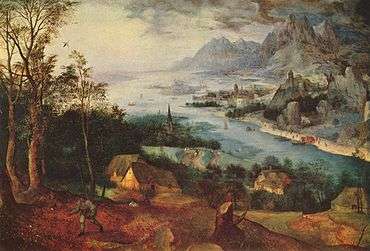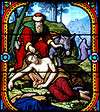Parable of the Sower

The Parable of the Sower (sometimes called the Parable of the Soils) is a parable of Jesus found in the three Synoptic Gospels[1] In the story, a sower sows seed on the path (way side), on rocky ground and among thorns, and it is lost; but when it falls on good earth it grows, yielding thirty, sixty, and a hundredfold.
Text (from the Gospel of Mark - KJV)
Hearken; Behold, there went out a sower to sow: And it came to pass, as he sowed, some fell by the way side, and the fowls of the air came and devoured it up. And some fell on stony ground, where it had not much earth; and immediately it sprang up, because it had no depth of earth: But when the sun was up, it was scorched; and because it had no root, it withered away. And some fell among thorns, and the thorns grew up, and choked it, and it yielded no fruit. And other fell on good ground, and did yield fruit that sprang up and increased; and brought forth, some thirty, and some sixty, and some an hundred. And he said unto them, He that hath ears to hear, let him hear.
— Mark, 4:3-9, KJV
 sower
sower birds
birds stony ground
stony ground thorns
thorns good ground
good ground
The explanation given by Jesus:
And when he was alone, they that were about him with the twelve asked of him the parable. And he said unto them, Unto you it is given to know the mystery of the kingdom of God: but unto them that are without, all these things are done in parables: That seeing they may see, and not perceive; and hearing they may hear, and not understand; lest at any time they should be converted, and their sins should be forgiven them. And he said unto them, Know ye not this parable? and how then will ye know all parables?The sower soweth the word. And these are they by the way side, where the word is sown; but when they have heard, Satan cometh immediately, and taketh away the word that was sown in their hearts. And these are they likewise which are sown on stony ground; who, when they have heard the word, immediately receive it with gladness; And have no root in themselves, and so endure but for a time: afterward, when affliction or persecution ariseth for the word's sake, immediately they are offended. And these are they which are sown among thorns; such as hear the word, and the cares of this world, and the deceitfulness of riches, and the lusts of other things entering in, choke the word, and it becometh unfruitful. And these are they which are sown on good ground; such as hear the word, and receive it, and bring forth fruit, some thirtyfold, some sixty, and some an hundred.
Context
In Mark's Gospel and Matthew's Gospel, this parable, the explanation of the purpose of parables and the explanation of the parable itself form part of Jesus' sermon delivered from a boat on the Sea of Galilee. In each narrative, Jesus used the boat as a means of being able to address the huge crowd gathered on the lake shore. Luke's Gospel does not use a boat for the delivery of the sermon, but still has Jesus presenting the parable to a large crowd gathered from 'every city' and follows the parable with a question on the purpose of parables and an explanation of the parable of the sower itself.
Whilst the parable was told to the multitude, the explanations were only given to the disciples.
Comparisons between Gospel of Thomas and Synoptic Gospels
Thomas, as usual, provides no narrative context whatsoever, nor any explanation, but the synoptics frame this parable as one of a group that were told by Jesus while he was standing on a boat in a lake. The parable tells of seeds that were scattered to blanket the area, some falling on the road and consequently eaten by birds and walked over by travelers, some falling on rock and consequently unable to take root due to the shallow soil, and some falling among thorns which choked the plants produced by the seed. It was, according to the parable, only the seeds that fell on good soil that were able to germinate, producing a crop thirty, sixty, or even a hundredfold, of what had been sown.
Though Thomas does not explain the parable at all, the synoptics state that the disciples failed to understand, and questioned Jesus as to why he was teaching by parables, but the synoptics state that Jesus waited until much later, until the crowds had left, before explaining the parables, stating to his disciples:
the secret of the kingdom of God has been given to you, but to those on the outside, everything is said in parables so that they may be ever seeing but never perceiving, and ever hearing but never understanding
The synoptics go on to state that Jesus quoted the Book of Isaiah, stating that by hearing you shall hear but not understand, by seeing you shall see and not perceive, and that the people were hard of hearing, with closed eyes Isaiah 6:9-10. After this, the synoptics provide an explanation of the parable:
- The sower sows the word
- The seeds falling on the road represent those who hear the word but dismiss it straight away - the synoptics state that the wicked one (Matthew's wording)/Satan (Mark's wording) is what takes the word away
- The seeds falling on the rocks represent those who hear the word, but only accept it shallowly - the synoptics state that these sorts of people reject the word as soon as it causes them affliction or persecution
- The seeds falling on thorns represent those who hear the word, and take it to heart, but allow worldly concerns, such as money and cares of this world, to choke it.
- The seeds falling on good soil represents those who hear the word, and truly receive it spiritually, causing it to bear fruit.
Interpretations

Most scholars think the parable was originally optimistic in outlook, in that despite failures eventually the "seed" will be successful, take root and produce a large "crop".[2] It is not the first parable (see Mark 2:19 and Luke 5:36; Mark 3:23) to occur in Mark, which according to the Q hypothesis was the first book it occurred in. Mark uses it to highlight the effect Christ's previous teachings have had on people as well as the effect the Christian message has had on the world over the three decades between Christ's ministry and the writing of the Gospel.[3]
Jesus says he is teaching in parables because he does not want everyone to understand him, only those who are his followers. Those outside the group are not meant to understand them. Thus one must already be committed to following Jesus to fully understand his message and that without that commitment one will never fully understand him or be helped by his message. If one does not correctly understand the parables, this is a sign that one is not a true disciple of Jesus.[4] He teaches in this way so that their sins will then not be forgiven. He quotes Isaiah 6:9-10, who also preached to Israel knowing that his message would go unheeded and not understood so that the Israelites' sins would not be forgiven and they would be punished by God for them.[3] There is some debate whether this was Jesus' original meaning or whether Mark added this interpretation himself.[4] The full explanation of the meaning of the parable stresses that there will be difficulty in Jesus' message taking hold, perhaps an attempt by Mark to bolster his readers' faith, perhaps in the face of a persecution.[5] This parable seems to be essential for understanding all the rest of Jesus' parables, as it makes clear what is necessary to understand Jesus is a prior faith in him, and that Jesus will not enlighten those who refuse to believe, he will only confuse them.[6]
The parable has sometimes been taken to mean that there are (at least) three 'levels' of divine progress and salvation.[7]
See also
Notes
- ↑ See Matthew 13:1-23, Mark 4:1-20, and Luke 8:1-15.
- ↑ Kilgallen p.82
- 1 2 Kilgallen p.83
- 1 2 Kilgallen p.84
- ↑ Kilgallen p.85
- ↑ Kilgallen p.86
- ↑ For example, Irenaeus writes, 'there is this distinction between the habitation of those who produce an hundred-fold, and that of those who produce sixty-fold, and that of those who produce thirty-fold: for the first will be taken up into the heavens, the second will dwell in paradise, the last will inhabit the city; and that was on this account the Lord declared, "In My Father's house are many mansions." Book V:36:1 (Against Heresies)
References
| Wikimedia Commons has media related to Parable of the Sower. |
- Kilgallen, John J., A Brief Commentary on the Gospel of Mark, Paulist Press, 1989. ISBN 0-8091-3059-9
- Bruce R. McConkie, Doctrinal New Testament Commentary, Vol. I:289
- James E. Talmage, Jesus The Christ, pg. 263-266
